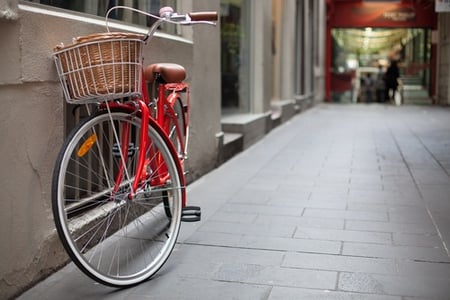
5 min read
I suffer from two common issues that could prevent me from being physically active. We’ve talked about them before: Lack of time, and lack of money.
Though I am kidding (a little!), I understand that these are real challenges that my colleagues and peers are often trying to overcome. For those trying to make improving employee wellness programmes a true priority at their organisation, these issues become all the more apparent.
But there’s a great way you can increase activity levels even when you’re someone who finds lack of time, or lack of funds, to be an issue.
For my fellow UK workers, we call it a Cycle to Work benefits scheme, but some parts of the programme can be easily replicated anywhere in the world. Here’s a look at how it works:
I’ve been commuting by bike off and on since 2003, and I currently cycle four days per week, with a round trip of 9 miles (50 minutes) each day. I do the same journey by tube once per week and this round trip takes me 80 minutes door-to-door. So we’ve eliminated that first issue of having no time — I actually get back a half hour of my day, plus gain nearly an hour of exercise. Just for commuting!
OK, onto that next issue — lack of money. I know that bikes can cost quite a bit of that! A couple ways you can tackle this is through the Cycle to Work scheme, where you can save on tax and NI for any bike up to £1,000 value while spreading the cost over 12 months. I tell my U.S. colleagues instead to look and see if their employer offers any kind of employee discounts on equipment or at specific retailers. Looking for a secondhand bike will also save you money, quickly and easily. Just make sure to lock it up when you get to work.
And what will cycling do for your travel costs? Well, with the journey I’ve told you about above you could save yourself £1,320 on the cost of your annual travel card, and if, like me, you still use public transport one day of the week, you’ll still save £1,000 over the course of the year.
When we’re looking at the exercise benefits, cycling to work is a no-brainer. Public Health England’s guidance on exercise is that we should be doing a minimum of 150 minutes of at least moderate exercise every week. So if you’re doing a 10 mile round-trip commute, you could happily hit the minimum recommendations by just cycling to work three days per week. Anything else you do on top of this is a bonus! (May I suggest these easy ways to get moving at work for starters?)
Key reasons why employees don’t cycle to work
Given all these benefits, what could possibly stop people from making the decision to get on their bike? I spoke to Paul Tuohy, Chief Exec of Cycling UK (the World’s biggest cycling charity which campaigns for an improved infrastructure to encourage more people cycle) to get his thoughts on the barriers to cycling to work.
He says the most often cited reason people give for not commuting by bike is their fear of being on the road with cars and other vehicles, though he points out that more people have accidents in their gardens and fall down the stairs than end up in A&E through bike accidents!
Paul also believes the growing phenomenon of "bike envy" leads many people to feel pressured to buy an expensive bike and get decked out in lycra, just for their commute. While he acknowledges that longer journeys may create the need for the rider to buy a better bike and wear cycling-specific clothing, the person doing 5 miles at a time should be able to get on anything with two wheels, wear their work clothes and pedal at a leisurely pace without needing to have a shower when they get to work.

There are a couple ways companies can encourage their employees to commute to work, whether or not a Cycle to Work scheme is a reality. Here’s a few:
- Consider a wellbeing allowance — Reward Gateway introduced this last year, and every employee receives an annual sum to spend on a variety of wellbeing activities. I use mine for a gym membership!
- Ensure a secure parking area for bikes so theft isn’t an issue or a barrier
- Outfit your workplace with a cloakroom area to hang up clothes so employees don’t need to carry everything in their bag to work every day
- Install a shower in your workplace, so there’s less hesitation to cycle to work
Although I would still choose to cycle to work without these benefits, the fact they’re there makes it all the easier for me to do so.
I’m willing to bet your employees will feel the same, once they understand the overall benefits of improving employee wellbeing. If you want to get started, find out more on our Cycle to Work pages or other ways to bring better wellbeing to your people.

 Nick Hudson
Nick Hudson





